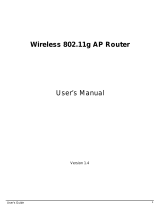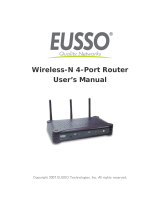
2
TABLEOFCONTENTS
INTRODUCTION ...............................................................................................................3
HARDWARE DESCRIPTION.....................................................................................3
HARDWARE INSTALLATION....................................................................................4
INITIAL CONFIGURATION ................................................................................................6
C
ONNECTING TO THE LOGIN PAGE ........................................................................6
STATUS PAGE................................................................................................................6
EASY SETUP ..................................................................................................................7
OPERATION MODE – AP ROUTER.........................................................................7
SETTINGS – PPPoE(ADSL) ........................................................................8
SETTINGS – STATIC (FIXED IP) .....................................................................9
SETTINGS – CABLE/DYNAMIC IP (DHCP)..................................................10
SETTINGS – PPTP.......................................................................................11
S
ETTINGS – L2TP .......................................................................................12
OPERATION MODE – AP BRIDGE........................................................................13
OPERATION MODE – CLIENT ROUTER ................................................................14
OPERATION MODE – CLIENT BRIDGE .................................................................16
ADVANCED SETUP .......................................................................................................18
MANAGEMENT..............................................................................................19
ADVANCED SETTINGS..................................................................................21
OPERATION MODE .......................................................................................22
FIREWALL CONFIGURATION ................................................................................23
MAC/IP/P
ORT FILTERING ...........................................................................23
VIRTUAL SERVER SETTINGS........................................................................24
DMZ.............................................................................................................25
FIREWALL.....................................................................................................26
CONTENT FILTERING....................................................................................27
NETWORK SETTINGS ...........................................................................................28
WAN ............................................................................................................28
LAN .............................................................................................................31
A
DVANCED ROUTING ...................................................................................32
WIRELESS SETTINGS ...........................................................................................33
B
ASIC ...........................................................................................................33
SECURITY .....................................................................................................34






















